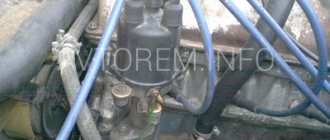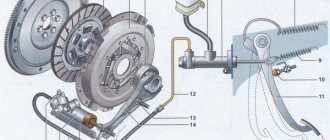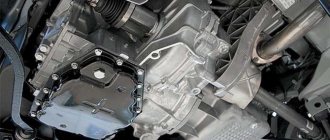Why can't you drive in neutral with a manual transmission?
Where do the roots of these disagreements come from? The fact is that in ancient times, vehicles were equipped with not very powerful engines, which overheated significantly when driving. Therefore, there was a driving style in which it was necessary to let the engine cool by reducing its speed. This was done by turning on the neutral gear.
In addition to the fact that on older engines this caused some cooling, but fuel consumption in this mode also decreased slightly. The logic here is simple. Less revolutions means less consumption. Today the situation with engine power is completely different. They are powerful and have the best cooling system.
Therefore, with a working cooling system, it is not necessary to drive in neutral to avoid overheating. Now, if the cooling does not work, then it is simply necessary to drive at a minimum speed so that the temperature does not go into the red zone. Moreover, the “heart” of a modern car is designed for a much higher number of revolutions than that of its ancestors.
How to learn to drive a manual transmission: All points, from A to Z
Today I want to tell you how you can quickly learn to drive a car with a manual transmission (or manual or standard transmission). With this detailed guide, you'll be able to start your car, get it moving, and then shift between gears without any problems. Don't be discouraged if you don't succeed right away. It also took me a while to get used to the manual box, but believe me, it’s worth it!
Practice, practice and more practice! Good luck!
At the end of the article you will find the most frequently asked questions about manual transmission and basic tips on how to drive a manual transmission.
Seven steps to your first manual ride
- 1. Find a good paved area where there are no people around so you can practice your riding.
- 2. While the car is not started, examine the transmission.
- 3. Depress the clutch and start the engine.
- 4. Shift the gear to first gear.
- 5.Slowly release the clutch until the car begins to move gradually.
- 6. With your left foot still on the clutch, now add some throttle by pressing the pedal with your right foot until the tachometer reads 1,000 or 2,000 rpm.
- 7. Now slowly release the clutch, but keep your right foot on the gas pedal.
If you press the gas pedal enough, the car will start moving forward.
How I learned to drive a car with a manual transmission
I've always wanted to learn how to drive a manual because I think it's cool. When I got my first manual car in 2012, I couldn't wait to get behind the wheel. I read some instructions and thought it wouldn't be that hard to learn. How wrong I was. My car, with its 412 horsepower and 390 torque Coyote engine, was difficult to drive. I went left and right.
My problem was that all the instructions I found online taught me to "lower the clutch slowly." I did so, but the car still shook. In the end, I realized that I don't have to press the gas to make the car go. Depending on the speed at idle, that is, when you do not press the gas pedal, you just need to release the clutch a little and the car will go.
I played with the clutch a little and felt the so-called clutch moment, that is, when the car is moving, but the clutch asks to add more gas. At this point, you feel a slight resistance and vibration from the clutch pedal; the car asks for more gas so that you can drive, releasing the clutch completely. When I tried this new method, I was able to start the car very smoothly. It's too bad no one told me about this before.
Adjust your mirrors
Adjust your side and rearview mirrors so you can see what's behind you and to the sides. Make sure you are in an area where no one is around and there is enough road ahead of you that you can reach different speeds without crashing into anyone.
Explore the gearbox
When the engine is not running, move the gearshift lever. The speeds on the lever are arranged in an "H" shape. However, the return stroke will be located differently in different levers. In this case, the reverse move is to the right and down.
Learning pedals
The far left one is not a pedal, it is a place where you can place your foot while moving. The clutch pedal is the second from the left. Next comes the brake pedal and the one on the far right is the gas pedal.
How to start a car in neutral gear
In order to start the car, the lever must be at neutral speed (the horizontal part of the lever), and the clutch pedal must be kept depressed at all times. To make sure you're in neutral, wiggle the lever a little.
To start the car, press the clutch pedal, hold it down and turn the key. Make sure the car is in neutral before releasing the clutch. Neutral gear is marked on the lever with a horizontal line. You can check if your gear is in neutral. To do this, lightly rock the lever left and right. If the lever moves, then you are in neutral.
How does a gearbox work in a car?
Well, now the engine is running, you are sitting, doing nothing and not going anywhere, which is not so bad to begin with.
Shifting to first gear
Hold the clutch and shift the lever to first gear. Usually this is a movement to the left and up from yourself.
Now, while holding the clutch pedal, shift the lever to first speed, that is, to the left and away from you.
Don't drop the clutch, otherwise the car will stall! Don't worry, you'll get the hang of it over time!
Hand brake
Some cars have a handbrake, parking brake, or brake control button (see above). Many other machines have a lever with a release button.
So, the car is moving. Now you need to make sure the handbrake is off. Since you are driving on a flat road, the car will still not roll away while you are thinking about what to do next.
Release the clutch and give gas
Release the clutch until you feel the car begin to move forward a little. Press the gas pedal until the tachometer shows 1,000 - 2,000 rpm.
When you are in first gear, slowly release the clutch until you feel the car start to move. This is the hardest part!
You must learn to feel this gripping moment when the machine begins to vibrate a little. Practice until you can automatically feel this moment, thanks to this, it will be easier for you to learn how to drive a mechanic.
Slowly, gradually increase the gas by pressing the gas pedal. There should be enough gas for the tachometer needle to stop between 1 and 2, that is, 1,000 and 2,000 rpm. If you give too little gas, the car will stall. If there is too much gas, you will start to burn the clutch. This often happens to beginners, but if this happens constantly, the clutch may wear out over time.
Release the clutch after shifting into gear
When you have added a little gas, do not rush to completely release the clutch. Release it when you feel the speed turn on. You can understand this by the vibration that you feel in your legs and that comes from the pedal. When this moment comes, you can completely release the clutch and drive calmly, as in a car with an automatic transmission.
Congratulations! You started a car with a manual transmission! It was easier for me to learn how to ride a manual once I learned about grip timing and how to feel it. I'm sure this is the easiest way to learn to drive a manual car.
: how to drive a manual car
In this video you will see what parts in the car you need to become familiar with, how to release the clutch pedal and how to press the gas pedal.
To shift from first to second speed, press the clutch and pull the lever down towards you. To shift to third speed, press the clutch pedal and pull the lever up and to the right.
I find changing gears much easier than trying to start the car. Just look at the lever and learn all the speeds. You shift from 1 to 2, to 3, 4, 5 and 6 speeds (if the car has six speeds).
How to switch to the highest speed? It's almost the same as starting a car, only much easier.
Let's say you are driving in first gear and are about to shift to second. Your actions:
- 1. Press the clutch, then shift the gearshift lever to second gear. In most cars, to change from first gear to second, you need to pull the lever towards you.
- 2. Slowly release the clutch until it engages, then add gas.
- 3. Release the clutch pedal and continue driving.
The transition from second to third and then fourth gear is the same and even easier. In order for the transition to be absolutely smooth, you will have to learn to balance the clutch and gas well. But all this comes with practice.
Shift into overdrive when engine reaches 2,500 rpm
In order to move from first gear to second and higher, monitor the tachometer readings. When the arrow points to 2,500 - 3,000 rpm, the car's engine is ready to shift to a higher gear.
How do you know when to change gear? Here you need to look at either the number of revolutions per minute or the speed at which you are moving. Typically, gear changes occur at 2,500 - 3,000 rpm.
As for speed and gear shifting, it all depends on the car, so check your car's manual. In general, speed is not as important for upshifts as it is for downshifts.
Over time, you will learn to understand by the sound of the engine and the general behavior of the car on the road when you can change gear.
The most frequently asked questions about manual transmission
How to start a car with manual transmission?
- 1. To start the engine, go into neutral. This is a horizontal line on the gearshift lever. Move the lever slightly to make sure the gear is in neutral.
- 2. Make sure the handbrake is on.
- 3. Please note that some cars will not start in neutral unless you keep the clutch pedal (left pedal) depressed.
- 4. Turn the ignition key.
- 5. You started the car!
How to drive a car with a manual transmission?
- 1. Once you have started the engine, keep the clutch depressed.
- 2. Shift the gearshift lever to first gear, that is, to the left and away from you.
- 3. Release the handbrake or parking brake.
- 4. Slowly release the clutch pedal and add gas.
Watch the tachometer needle. You can fully release the clutch when the needle shows 1,000 - 2,000 rpm. - 5. Continue driving in first gear.
- 6. If the car stalls, raise the handbrake, press the clutch pedal, move the lever to neutral and start the engine again.
My car stalled. what to do?
First, you need to calm down. There's nothing wrong with the car, you didn't break anything. Simply press the clutch pedal again and turn the key. The car will start again. Just make sure the lever is in neutral and do the same steps again.
Double Clutch Shift Pattern, Why Use It, How It Works, and How to Apply It in Everyday Situation?
Why did the car stall? You put the lever into first gear, but did not give enough gas to move the car. The car wanted to go, but it didn’t have enough gas and it stalled.
How to stop a car with a manual transmission?
You don't have to press the clutch pedal every time you step on the brake pedal to stop the car. But if you need to come to a complete stop at a sign or at a traffic light, then press the clutch when the car has almost completely stopped moving and move the gearshift lever to neutral, otherwise the car will stall.
How to reverse?
- When the car has completely stopped, press the clutch pedal and move the lever to the reverse position.
- Look in the rearview mirror and make sure there are no obstacles behind you.
- Release the clutch slightly when you feel it reverse.
- When driving backwards, always look in the rearview mirror.
Why drive a car with a manual transmission?
So what are the benefits of a manual transmission?
- You can completely control the speed; a manual car is more economical and efficient than an automatic car.
- Since you control the speed, you can accelerate faster and change speeds whenever you want.
3. Driving a manual may seem difficult at first, but after a couple of weeks it will become second nature.
Source: https://1gai.ru/baza-znaniy/519199-kak-nauchitsya-ezdit-na-mehanicheskoy-kpp-vse-punkty-ot-a-do-ya.html
Coasting safety
Next, it’s worth speculating about how safe it is to coast. The Rules have a definition of driving safety, which boils down to the fact that you need to drive correctly in order to avoid accidents. There are three ways to maneuver in neutral that will help avoid an accident:
- Changing the direction of movement by turning the steering wheel;
- By braking with both the service brake and the engine (by releasing the gas pedal);
- Increasing speed and pressing the gas pedal.
Acceleration is not possible
The driver can use the brakes or turn the steering wheel at any time. But to speed up (often you need to speed up to avoid an accident) will no longer work, because you need to engage the gear and press the gas pedal to the floor, and this is a waste of precious time, when not even a second, but a fraction of a second matters.
As a result, neutral gear does not allow you to use all three methods in order to avoid an accident. This may be tantamount to the fact that the car simply does not have a brake pedal or steering wheel. This way, it will probably be clearer for those drivers who want to travel as safely as possible.
Neutral transmission on an automatic transmission: why is it needed, when can and cannot be turned on
Hi all! Modern cars are equipped with different gearboxes, but some components remain the same. For example, this is a neutral gear on an automatic transmission, on a manual transmission and on the same sequential gearbox.
Having not studied the principle of operation, motorists who previously drove a manual gearbox begin to ask all sorts of questions due to the habits formed at the previous checkpoint.
In particular, not everyone understands why neutral is needed on an automatic transmission, whether it is possible to coast in this case, and how to use this gear correctly so as not to harm your own vehicle.
But not everything that can be done with neutral on a manual transmission can be done on an automatic transmission. That's what this material was prepared for. Today we’ll talk about such a unit as an automatic transmission and neutral on it.
Why is there neutral on the automatic?
You probably know why you need a neutral on the box. If not, then I remind you.
If you suddenly forgot which letter is used to designate neutral gear, then I will say that it is N.
When the gearbox lever is moved to the neutral position, the torque from the engine installed on the car is not transmitted to the wheels. Thus the car does not move.
Neutral on manual transmissions is used almost constantly and everywhere. And precisely at traffic lights, when idle in traffic jams, etc. In the case of an automatic transmission, the role of neutral is significantly simplified. Much fewer functions and responsibilities are transferred to it compared to mechanics. This is why difficulties arise when switching from a manual transmission to an automatic transmission. Then it turns out that the box is shaking and breaks down, because the driver simply mismanaged the neutral gear, transferring habits from the mechanics.
There are a number of drivers who, during the entire period of operating an automatic transmission, have never even engaged neutral.
However, this mode is still extremely necessary on any car equipped with an automatic transmission.
Neutral on an automatic transmission plays a key role when towing a car.
If you look at the instruction manual, you can find useful and important information there. Automakers recommend turning on the N position on the box when towing.
In fact, the automatic transmission drives in neutral when towing, but at a speed not exceeding 50 kilometers per hour.
There is also additional information in the recommendations. According to the requirements of automakers, they advise towing a car with neutral on for no more than 50 kilometers. This is the maximum permissible distance. If you have to cover more serious distances, then you should use the services of a tow truck or towing with raised drive wheels. Otherwise, serious malfunctions may occur.
It's hardly worth risking the integrity of the box.
Neutral can also be used in the riser if there are problems with the parking mode. But this is a last resort. Before parking the car, make sure that mode P is selected.
Neutral in traffic jams and traffic lights
If you are a former owner of a car with a manual transmission, then switching to a CVT or automatic transmission may cause some problems in the initial stages of operating an automatic transmission.
A very common habit is to act at traffic lights and in traffic jams.
All manual drivers know that when approaching a traffic light or getting into a traffic jam, it is necessary to move the gearbox handle to the neutral position. And start from there when the green light turns on or the traffic jam moves. This is what motorists do to be able to remove their foot from the clutch. But the automatic machine simply does not have this pedal. Therefore, there is also no need to switch to a neutral position. Everything is extremely simple. But we need to study the issue in more detail.
It is necessary to understand why this mode cannot be enabled. When the driving mode is activated (Drive, Drive or D), the torque converter builds up pressure in the box, which facilitates the transmission of torque.
In this mode, all internal elements are actively lubricated. If the gas pedal is not depressed, the transformer is in the so-called green zone. Then there is only lubrication, and nothing more.
If you switch to neutral, both shafts (output and input) will open. This will stop the lubrication process.
When you see a green light turn on in front of you, or realize that the traffic in a traffic jam is about to start moving, by switching to neutral first and then switching to drive again, you will create conditions of serious stress for your transmission. This is due to the fact that the pressure inside the system will change dramatically. Therefore, the automatic transmission components will have to perform additional manipulations and movements, which will ultimately affect the life of the entire gearbox.
The same should be considered when you are in a traffic jam. In traffic jams there is no need to switch from drive to neutral.
How to brake correctly with manual brakes
Summarizing the above, we can say that it is safest to brake with the gear engaged. This is the so-called combined braking, which saves fuel and prevents the wheels from blocking. The latter, of course, is more relevant for older cars that are not equipped with ABS. The engaged gear also allows you to have a reserve of traction, which can be useful when accelerating or braking the engine.
It is advisable to engage neutral gear only when the car is completely stopped, while proper braking is carried out in gear until the car comes to a complete stop.
Automatic transmission modes
Before we begin to understand the essence of neutral on an automatic transmission, let’s remember what gears exist in modern automatic transmissions.
In most modern car models with an automatic transmission, there are 5 positions, marked with letters on the operating panel next to the selector lever.
- The main position of the gear selector in automatic transmission, which ensures the vehicle moves along the road, is D, or Drive;
- Parking position – P stands for Turns on when the vehicle stops;
- Neutral mode N, or Drivers nicknamed it neutral. We will talk about it in more detail below.
- Reverse gear is marked with the letter R, which means Reverse.
- OVERDRIVE transmission, marked on the panel with the letters O/D. Not available at all checkpoints. On five-speed automatic transmissions, overdrive can be turned off by simply pressing the button.
Read
How to replace an automatic transmission with a manual transmission in your garage











